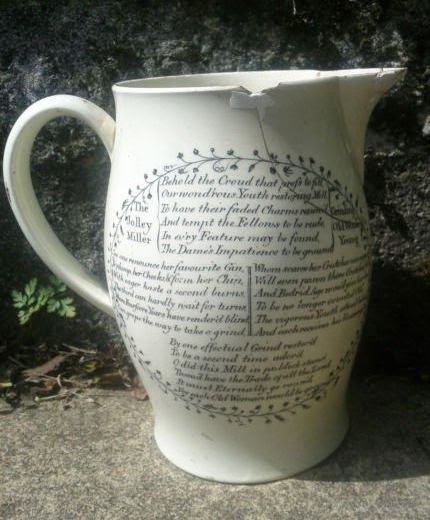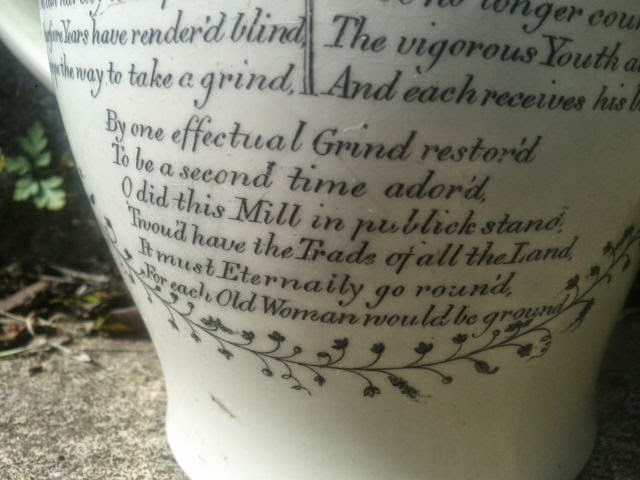Liverpool
Creamware Pottery
“
I am all for the short and merry life” (Fitzgerald)
When
one thinks of Liverpool, one thinks of The Beatles, the two football
clubs and maybe of Cilla Black, but how many of us consider a
Liverpool pottery. But yes, there was one once located in the
unfashionable suburb of Toxteth next to the River Mersey. It has been
closed for over one hundred and seventy years but its impact is still
being felt.
Whilst
I had heard of Creamware, it was not until recently that I found out
about the short life of the Liverpool Pottery and when researching
the subject I found something of a Pandora’s Box of information
hidden just under the surface.
I
have only been to (or through) Toxteth twice in my life, both times
when returning from football matches. Like many areas it has suffered
over the years and would be the last place that you would connect
with a pottery. Yet, its location next to the river was by far the
most logical place for it to be. If you were looking for it now then
you would be hard pressed to find any trace of it as after its
closure in 1840, the area in time became what was known as the
Herculaneum Dock (it
even had its own station on the network of the famed Liverpool
Overhead Railway)
before the dock in turn closed in 1972. I am told that the area is
now covered by a riverside development as well as being used for
the Liverpool
Garden Festival.
 Creamware
Creamwareitself was created in the 1750s in Staffordshire and proved popular
for domestic use and it was inexpensive against the Chinese export
pottery of the time. A name forever connected with creamware
was that
of Josiah Wedgwood. But it was not Josiah who was involved in the
Liverpool Pottery but a Richard Abbey who in the early 1790s could be
found as an apprentice to an engraver named John Sadler at Toxteth
Park.
In
1793 he branched out and started the pottery with a friend from
Scotland named John Graham. Three years later they sold the business
to a concern named Worthington,
Humble and Holland.
Little is known about this business although they did employ some
forty men from the Staffordshire potteries who they transported to
Liverpool by boat. The initial buildings that were purchased from
Richard were enlarged and considerably improved and the pottery was
named The
Herculaneum Pottery partly
because Josiah had called his works Etruria.
Both
these imaginative brandings are remembered to this day.
Their
early productions were of printed earthenware, which, because of its
deeper shade could be differentiated from Josiah’s products. As I
have already noted the location of the pottery on the shores of the
Mersey was important as the business did a very good trade with
America. Many of the early designs were devoted to American themes.
English themes were also produced with landscapes being especially
popular.
 As
Asadvances were being made the company moved with these producing
Terracotta items as well statuettes and figures in relief and a
number of other products. The company expanded again in 1800 and was
enlarged even more in 1806. The reason for this may be, apart from
its home popularity, the American and Canadian markets relied on
Herculaneum a great deal for their fine wares. There is a very
readable book called simply, The
Herculaneum Pottery (Liverpool’s Forgotten Glory) by
Peter Hyland, which covers the subject in far greater depth.
It
came as a bit of a surprise to me that just over thirty years later
in 1833 the company was dissolved and sold for just £25,000 to a
certain Ambrose Lace who in turned leased the works to a Thomas Case
and James Mort. Their legacy was that they introduced the Liver
trademark (the crest of Liverpool) onto their products. The company
lingered on to around 1840 when it closed its doors forever. One of
the reasons for its closure after such a short period I suspect was
the rapid growth of the Staffordshire potteries. They could not
compete with their rivals.
It
was a brave attempt in the first instance and for a few short years
it was a shining light in Liverpool. If I am not mistaken, there would
have been other much smaller potteries dotted around the country but
like The
Herculaneum Pottery, these
would have been swallowed up by much bigger concerns. We all like the
idea of small independent businesses but what is true today, was just
as true then.
 Although
Although
I do not collect Creamware one of the features that I do enjoy is the
actual freshness of the design and the lack of actual colour. There
is an example at the V&A of a Creamware plate dating from
c1780/90. On a first viewing the plate looks almost under designed
but on closer study the design is quite complex. Two peacocks and an
unidentified bird in flight are featured but the positioning of the
birds and use of the foreground detritus and the background trees
(not forgetting the bird in flight) together present an exquisite
scene. The bordering of the plate only adds to the effect.
Whilst
Herculaneum and other potteries did not exclusively work in
monochrome, (blue was often used especially when copying Chinese
patterns) the effect of what could be loosely termed black
on white was
quite memorable. Whilst researching this article, I have found many
examples of the Liverpool pottery. Some of the earlier ones are in
their way quite haunting. When showing scenes (of the areas around
Liverpool for instance) there is a vacancy, yet the views are full of
detail. Where buildings and the urban sprawl now exist, there were
fields and the area was as rural as the areas around Hungerford are
today. The medium was perfect for this representation.
As
tastes changed in the nineteenth century, in my view, the designs
became very complicated and the simplicity of the earlier works was
lost. Many people like these baroque designs but whilst appreciative, they are not for me. It is almost looking back into your childhood
and thinking of Those
Blue Remembered Hills.
Scenes
of the rural life were not the only decorations applied to the works
from Herculaneum. The medium presented myriad opportunities. If there
was a grand civic event then this would have been recorded on the
commemorative pottery of the day. Obviously, anything royal would have
been celebrated. As Liverpool was the gateway to America and the last
city many emigrants saw before they left, it is likely that the
many ships may have been represented (although I have not seen
examples). The trade of the city would have been celebrated
also.
Liverpool
was foremost an industrial city and with this came the rise of the
trade unions who, as they do today, tried to ensure that the average
working man was treated fairly and with the respect due to him. As
these unions grew then they too celebrated their achievements and
commissioned various items of pottery (jugs etc) to commemorate
themselves.
 One
One
thing that the people in Liverpool are renowned for is their sense of
humour and an example that I recently noted was the Old
Maids into New Maidens theme
that was frequently used. There are very likely to have been many
variations on this theme and explorations into the lands of
Hogarthian and Liverpool wit. Figures of fun such as jesters would
have been represented widely as well as, I would imagine, satires on
many famous Victorian figures.
Obviously
due to the relatively short lifespan of the Herculaneum
Pottery, the
pieces produced are highly collectable and sought after. I believe
that there are examples in a museum in Liverpool as these are prized
relics of the city’s past. The exportation of many works to the USA
and Canada also means there is a market overseas and this in turn
will drive the prices higher. I have looked on the internet and there
is a whole raft of prices but some of the pieces on sale do look
quite worn. It is very much like most things, the better the
condition of the item (and taking into account its rarity) the more
one is likely to pay.
It
is not an item that you are likely to come across at a boot sale or jumble
sale (although never say never). You are more likely to see examples
in antique establishments. If you know what you are looking for then
you will know your purse. If I was to buy a piece of Liverpool
Creamware, then I think I would choose an early piece (pre1806). I
would not greatly care of its condition as I would like to connect
with its origins in Toxteth next to the River Mersey, before this area
was swallowed up by the city of Liverpool.
Jolley Miller, Grinding Old Women Young
the crowd that prefs to fill,
wondrous youth restoring mill,
have their faded charms renew’d,
tempt the fellows to be rude,
ev’ry feature may be found,
The
Dame’s impatience to be ground.
See
one renounce her favourite Gin,
plump her cheeks & form her chin,
eager haste a second burns,
third can hardly wait for tunrs,
fourscore years have rendered blind,
grope the way to take a grind.
scarse her crutches can support,
even pawn those crutches fort,
bedrid Age would give her Gold,
be no longer counted old,
vigorous youth attend below,
each receives his blooming Doe.
one effectual grind restor’d,
be a second time ador’d,
did this Mill in publick stand,
have the trade of all the land,
must eternally go roun’d,
each Old Woman would be ground.

